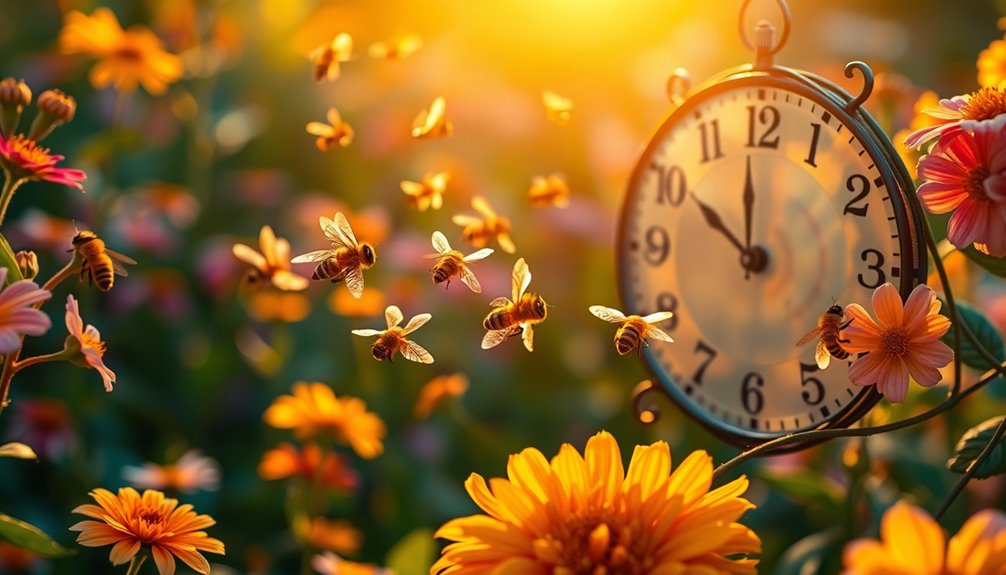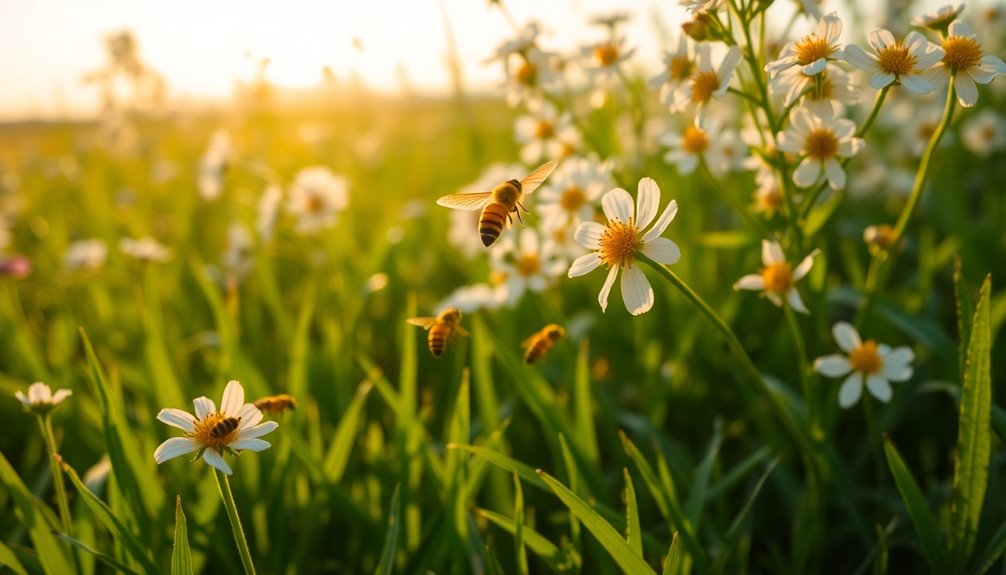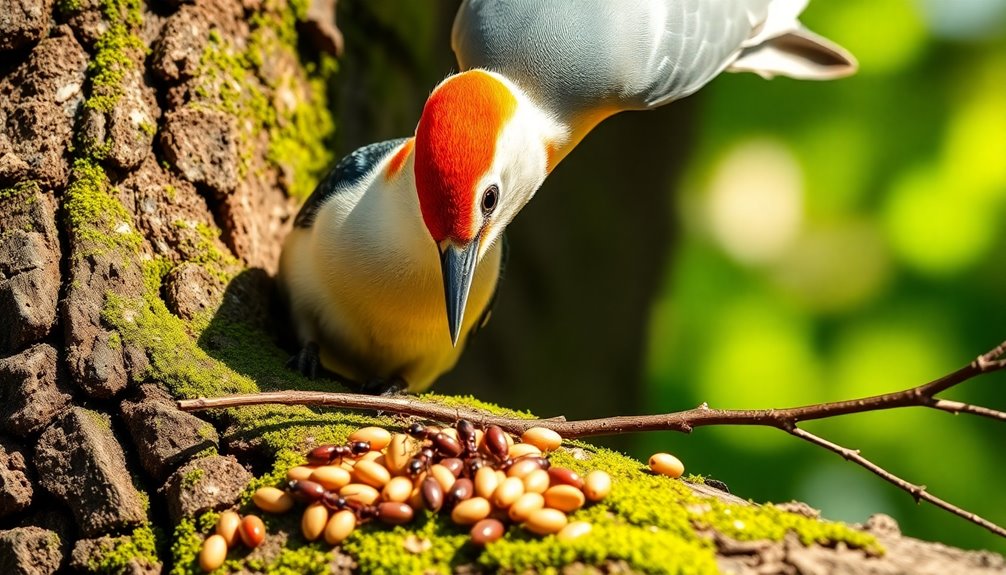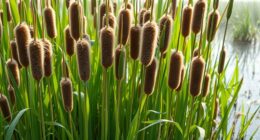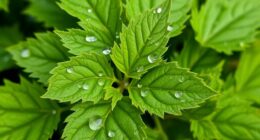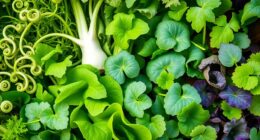You can easily forage a variety of nutritious plants right outside your door, creating a free feast. Look for dandelions and wild garlic in your garden or nearby parks; both are abundant in spring. As summer rolls in, grab blueberries and wild mint for a revitalizing treat. Late summer brings elderberries and fall offers chestnuts. Always double-check your finds to verify they're safe to eat, avoiding toxic lookalikes. Start small and incorporate these ingredients into your meals. If you're curious about more foraging options and tips, there's plenty more to explore about this rewarding hobby!
Key Takeaways
- Common edible plants like dandelion, wild garlic, and plantain are easily found in backyards and urban areas during spring and early summer.
- Seasonal fruits such as blueberries, mulberries, and raspberries can be foraged in summer and early autumn, adding variety to your diet.
- Unique ingredients like purslane, young nettles, and wood sorrel offer diverse flavors and nutritional benefits for salads and dishes.
- Infusing oils and teas with foraged plants, like dandelion and wild mint, elevates meals and provides unique culinary experiences.
- Engaging with local foraging workshops and community groups enhances knowledge of edible plants and safe foraging practices in your area.
Understanding Foraging Basics
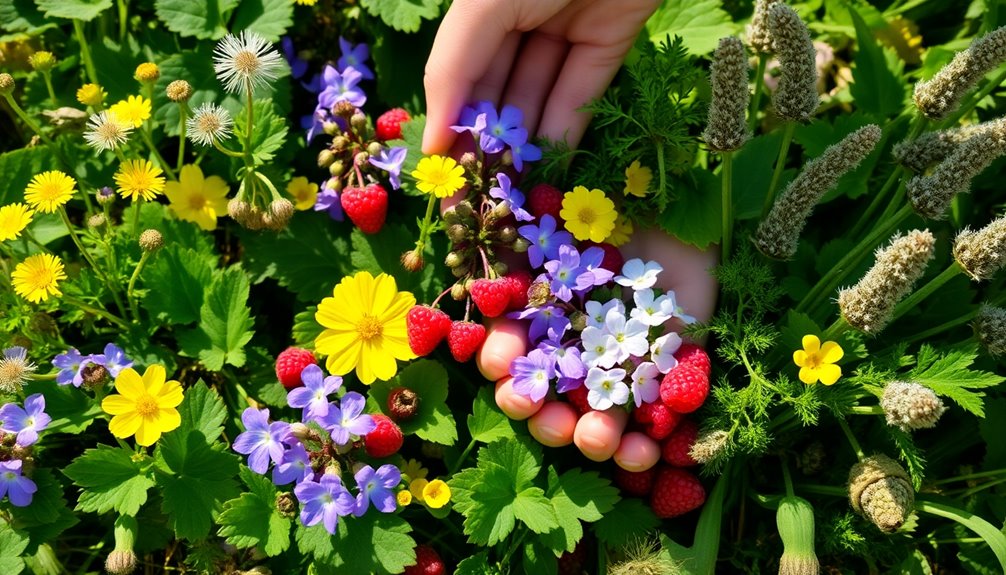
Foraging for food is a rewarding adventure that starts right in your backyard. You might be surprised to find that common backyard weeds, like dandelion and plantain, aren't only easy to identify but also packed with nutrients.
Understanding the basics of foraging involves recognizing these edible plants and familiarizing yourself with the local flora. Many backyard weeds, including purslane and yarrow, offer delicious and nutritious options for your plate.
Using plant identification guides and apps can noticeably enhance your foraging experience. These tools help you distinguish between safe wild edibles and their poisonous look-alikes, which is essential for safe foraging practices.
Remember, mastery of foraging takes time and practice, so don't rush it. Start with a few easily recognizable plants to build your confidence.
Taking close-up photos of the plants you encounter can also aid in later identification and deepen your understanding of foraging. This hands-on approach will enrich your learning experience and make each foraging outing feel like an exciting treasure hunt. Additionally, learning about historical significance of foraging can provide valuable context to your discoveries.
Identifying Edible Plants
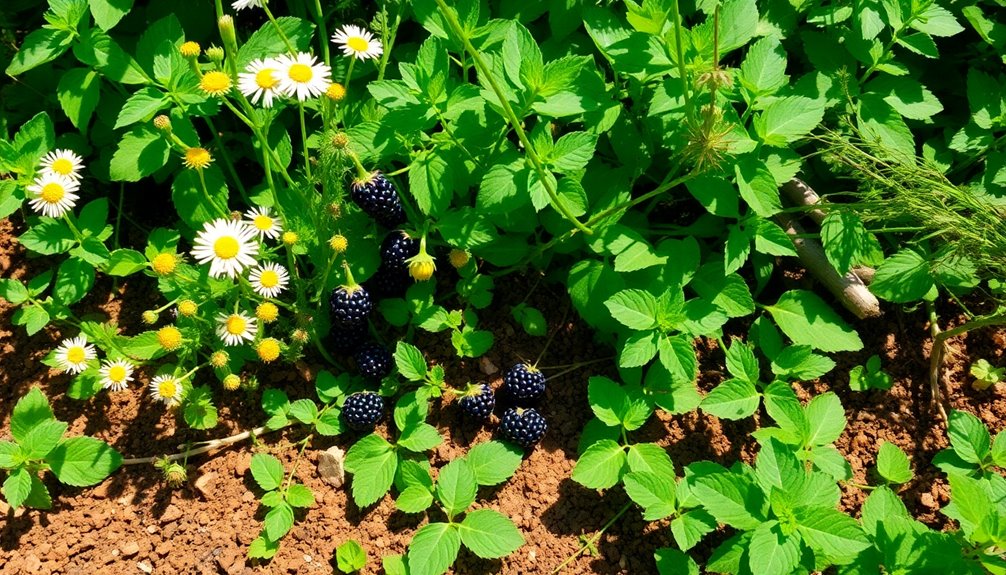
When you're foraging, knowing which plants are safe to eat is essential for a successful harvest.
Familiarize yourself with common edible plants like dandelion and wild garlic, but stay alert for toxic lookalikes like water hemlock.
Common Edible Backyard Plants
Backyards can be treasure troves of delicious and nutritious plants waiting to be discovered. You might be surprised by the common edible backyard plants growing right outside your door.
Dandelions are among the most recognizable wild foods; their leaves can spice up salads, and their flowers are perfect for fritters. Plantain, another backyard gem, offers medicinal benefits and versatility in dishes.
Don't overlook violets, whose edible flowers and leaves can add color and a mild flavor to your meals. Clover is another excellent source of free food, with its leaves and flowers packed with protein, perfect for teas or snacking.
If you're looking for a zesty addition to your salads, wood sorrel's heart-shaped leaves provide just the right tartness. Purslane, with its succulent leaves, is rich in omega-3 fatty acids and works wonderfully in salads or stir-fries.
Finally, yarrow, often dismissed, has young leaves suitable for salads and flowers that enhance teas. By embracing urban foraging, you can enjoy these delightful plants while enhancing your culinary repertoire. For those interested in expanding their knowledge, local foraging groups offer workshops and resources to help identify and sustainably harvest wild edibles.
Identifying Toxic Lookalikes
Identifying edible plants can be a rewarding adventure, but it's essential to recognize their toxic lookalikes to stay safe. Many wild foods, like wild garlic, can easily be confused with poisonous plants such as lily of the valley. Proper identification is fundamental to avoid serious health risks. Understanding the importance of traditional healing practices can also enhance your knowledge of foraging and its cultural significance. Additionally, many cultures have historically utilized honey production as a natural remedy, often incorporating foraged plants into their practices.
Take elderberry leaves, for instance; they're safe to eat when cooked, but they can resemble the toxic leaves of yew, which can be harmful if ingested. Sustainable harvesting techniques can also support the conservation of wild plant populations while foraging responsibly.
When foraging for mushrooms, be aware that delicious chanterelles have toxic counterparts, like false chanterelles, making careful examination critical for safe consumption.
To differentiate between edible varieties and their toxic lookalikes, pay attention to habitat, leaf shape, and flowering patterns.
Utilizing reliable field guides or apps that provide detailed photographs and descriptions is key. These resources help you confidently identify edible plants while steering clear of potentially dangerous ones. Additionally, some plants, like cilantro for dogs, can be safe for consumption, but always ensure proper identification and caution to avoid confusion with toxic varieties.
Seasonal Availability of Edibles
Understanding the seasonal availability of edible plants can greatly enhance your foraging experience. Knowing when to look for specific plants helps you maximize your finds. In urban areas, for instance, spring and early summer are ideal for foraging wild garlic and dandelions. As the seasons change, so do the edible options available. Many families enjoy water park amenities as part of their vacation plans, which highlights the importance of outdoor activities like foraging.
Here's a quick reference to help you plan your foraging trips:
| Season | Edible Plants | Notes |
|---|---|---|
| Spring | Dandelions, Wild Garlic | Abundant and easy to find |
| Summer | Blueberries, Wild Mint | Check local climate conditions |
| Late Summer | Elderberries | Ripens late summer to fall |
| Autumn | Chestnuts | Look for fallen nuts |
| Year-Round | Lambsquarters | Harvest when available |
Culinary Uses of Foraged Foods
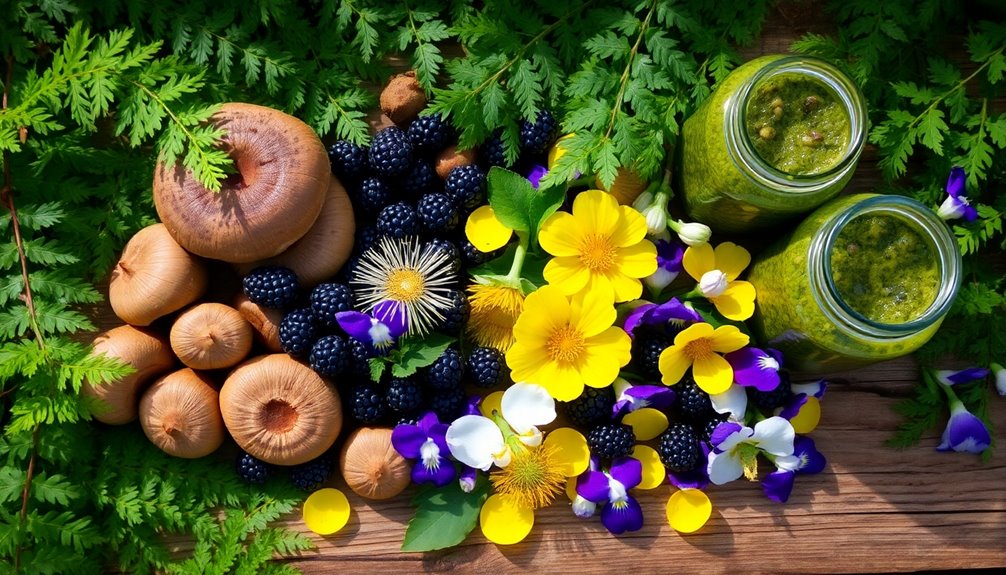
When you think about foraged foods, consider how wild greens can elevate your salads with fresh flavors. You can also explore unique appetizers that highlight the distinct tastes of foraged ingredients. Plus, infusing oils or teas with these finds adds an exciting twist to your culinary creations. For optimal health benefits, it's important to ensure a nutritional balance in your foraged meals, incorporating proteins, carbohydrates, and fats.
Wild Greens in Salads
Have you ever considered the delightful flavors and nutrients that wild greens can bring to your salads? Foraged wild greens like dandelion greens and lambsquarters aren't only edible but also nutrient-rich, offering a fantastic boost to your meals.
Young nettles, when cooked, lose their sting and add a unique, earthy taste that enhances the overall flavor of your salad while providing additional vitamins.
Purslane, a succulent wild green, brings a slightly tangy flavor and is high in omega-3 fatty acids, making it a perfect complement to your salad mixes.
Don't forget about wood sorrel; its invigorating tartness can brighten up even the simplest salad, adding a delightful twist.
You can also incorporate wild herbs such as wild mint or wild chives into your salads. These fragrant additions enhance the flavor profiles and bring a fresh, aromatic quality that elevates your dish.
Unique Flavorful Appetizers
Elevate your appetizer game by incorporating foraged foods that burst with unique flavors and textures. Foraging opens up a world of edible treasures right outside your door, and you can transform these wild ingredients into flavorful dishes.
Start with dandelion fritters, where you batter and fry the flowers for a unique appetizer showcasing their slightly bitter taste.
If you're looking for something fresh, wild garlic offers a distinct aroma that can elevate traditional pesto, adding a vibrant twist to your spread.
Don't overlook purslane, either; its succulent leaves can be mixed into a vibrant salad or blended into a rejuvenating cold soup, providing a burst of flavor and nutrition.
For a sweet touch, consider wildflower-infused cookies. These delightful treats not only satisfy your sweet tooth but also bring natural floral notes to the table.
Lastly, incorporate wild greens like lambsquarters or chickweed into savory dips or spreads. They'll enhance your appetizers while boosting their nutritional profile.
With these unique and edible foraged options, your appetizer repertoire will impress everyone at your next gathering!
Infused Oils and Teas
Foraging opens up exciting possibilities in the kitchen, especially when it comes to creating infused oils and teas that highlight the natural flavors of wild ingredients. You can easily craft infused oils by combining wild herbs like rosemary or garlic mustard with a carrier oil, allowing those bold flavors to meld. For a floral twist, try steeping edible flowers like calendula or chamomile in oil, capturing their unique essence for dressings or even massage oils. The process of brewing the perfect cup of tea can also be applied to foraged ingredients to enhance their flavors. Additionally, you might consider incorporating natural remedies into your foraged creations to boost health benefits.
When it comes to herbal teas, foraged ingredients shine. Brew invigorating drinks using wild mint or lemon balm for a natural flavor boost. Additionally, dandelion leaves and flowers can create both dandelion tea and infused oils, adding nutritious elements to your meals. Incorporating omega-rich seeds into your foraged recipes can enhance the nutritional profile of your dishes.
To keep things organized, here's a quick reference:
| Type | Ingredients | Uses |
|---|---|---|
| Infused Oils | Wild herbs, edible flowers | Dressings, cooking, massage |
| Herbal Teas | Foraged berries, mint, lemon balm | Invigorating beverages |
| Dandelion | Leaves and flowers | Dandelion tea, infused oils |
Explore these wild creations and elevate your culinary adventures!
Safety Tips for Foraging
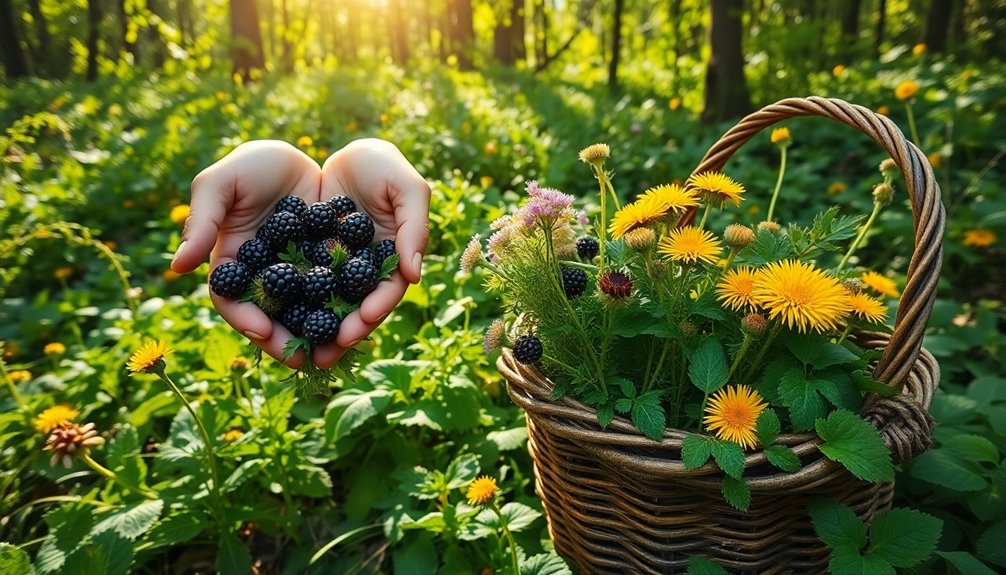
When you venture into the world of foraging, safety should always be your top priority. To guarantee a successful and safe experience, keep these essential tips in mind:
- Identify carefully: Always confirm the identity of edible plants using reliable field guides or apps. Misidentification can lead to consuming toxic varieties.
- Start small: When trying new plants, begin with small quantities to monitor for any allergic reactions or digestive issues before adding them to your diet.
- Avoid contaminated areas: Stay away from locations that may be polluted or contaminated with pesticides, pollution, or animal waste. This helps guarantee the safety of the food you gather.
- Know local regulations: Be aware of local regulations regarding foraging. Obtain permission for harvesting on private property and respect protected areas.
Understanding the seasonal availability of plants will also enhance your foraging success.
Familiarizing yourself with local flora is vital for both safety and maximizing your foraging potential.
Prioritizing these steps won't only keep you safe but also make your foraging adventures more enjoyable. Happy foraging!
Urban Foraging Opportunities
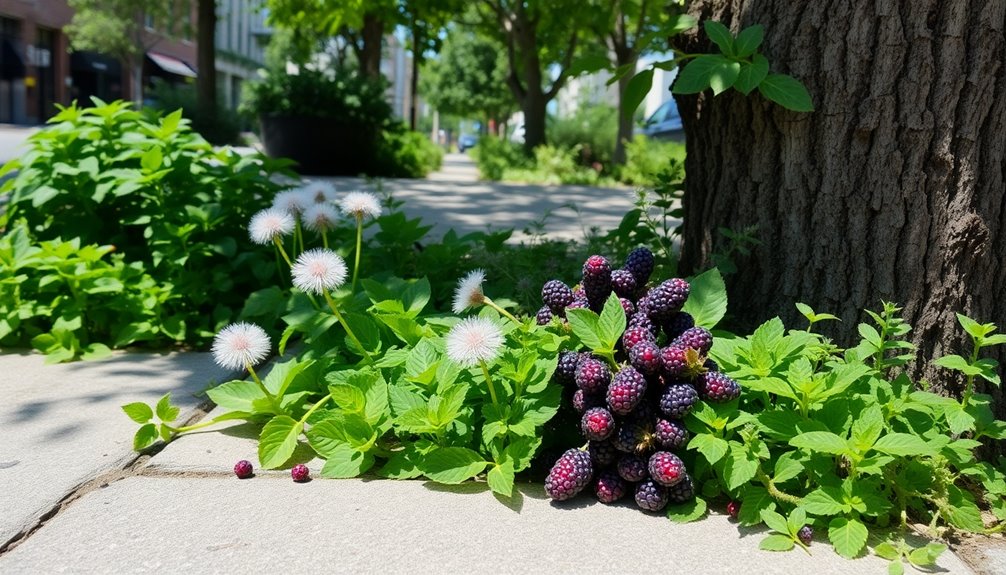
Exploring urban environments can reveal a surprising abundance of wild edibles right at your doorstep. Urban foraging offers a treasure trove of ingredients, including dandelion greens, wild mint, and serviceberries, often found in parks, gardens, and along city streets. Foraging in urban settings not only allows you to enjoy these delicious treats but also reflects the foraging range of local pollinators that contribute to the ecosystem. Additionally, many urban areas may have home security systems that ensure the safety of foragers while they explore. Chia seeds, for instance, can also be grown in urban gardens, providing a sustainable source of nutritional value for those interested in home cultivation. Incorporating essential oils into your foraging practices can enhance both the flavor and health benefits of your wild edibles.
You might be amazed by the unharvested fruit trees and berry bushes scattered throughout your neighborhood, providing easy access to seasonal fruits like mulberries, raspberries, and wild grapes.
Foraging in urban settings isn't just about saving money on groceries; it's also a fantastic way to connect with nature and learn about local flora. Additionally, incorporating foraged ingredients into your meals can enhance your overall wellness, as many wild edibles possess health benefits that contribute to emotional and physical wellbeing.
To enhance your skills, consider attending community workshops or exploring online resources that can help you identify safe and edible plants in your surroundings.
Community Resources and Engagement
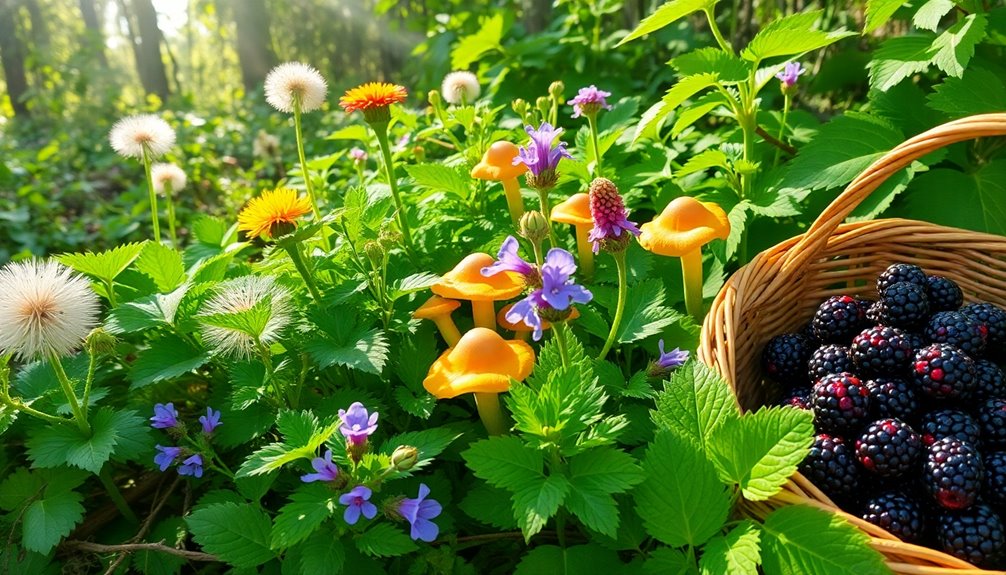
Participating in community resources and engagement can considerably enhance your foraging journey. By connecting with local groups and initiatives, you can deepen your knowledge and skills in foraging. Here are some ways you can get involved:
- Community Workshops: These often feature plant identification training and promote sustainable foraging practices.
- Local Nature Walks: Join guided tours to explore your area's edible plants and learn about their uses.
- Foraging Classes: Many counties offer educational resources through extension services, teaching you about local flora.
- Connecting with Experienced Foragers: Engage with local foraging groups to gain valuable insights and build connections.
The Herbarium at the Herbal Academy is another excellent resource, providing identification guides to help you recognize wild plants confidently. Engaging in local foraging efforts not only enhances your experience but also helps cultivate a sense of community among those who share similar interests.
By participating in these community resources, you'll not only improve your skills but also foster a sense of camaraderie with fellow foragers.
As you learn about sustainable foraging practices, you'll contribute to the preservation of local ecosystems while enjoying the free feast right outside your door.
Embrace these opportunities, and watch your foraging journey flourish!
Frequently Asked Questions
What Is the Easiest Food to Forage?
When you're looking for the easiest food to forage, dandelions often top the list.
They're everywhere and you can't miss their bright yellow flowers. Both the leaves and flowers are edible and packed with nutrients.
Plus, they're versatile in salads or teas.
If you want something a bit different, try wild garlic, which has a distinct smell and adds great flavor to dishes.
Just be sure to identify them correctly before consuming!
Is It Illegal to Forage for Food?
You can't just wander around grabbing food like it's a buffet!
Whether foraging is illegal depends on where you are. Many regions have laws governing wild edibles, especially on public land. You'll need to check local regulations before harvesting anything.
If you're on private property, getting permission is a must. Remember, some areas even prohibit foraging to protect ecosystems.
Always stay informed to avoid fines and guarantee responsible foraging practices!
What Is the Easiest Food to Find in the Wild?
When you're looking for the easiest food to find in the wild, dandelions are your best bet. Their bright yellow flowers and serrated leaves pop up in lawns and meadows everywhere.
You can harvest both the leaves for salads and the flowers for teas.
Another great option is plantains, which thrive in disturbed soil and offer a wealth of nutrients.
Keep your eyes peeled, and you'll discover these wild edibles easily!
What Not to Eat When Foraging?
When you're foraging, steer clear of any plants that resemble familiar edibles, like the treacherous water hemlock masquerading as parsley.
Don't touch mushrooms unless you're absolutely sure of their identity; many can be fatal.
Avoid gathering from polluted areas, too, since toxins can lurk there.
Remember, some plants, like elderberries, need cooking first.
Start with small amounts of new finds to guarantee you don't have any adverse reactions.
Stay safe!
Conclusion
In the tapestry of nature, foraging weaves a vibrant thread of flavor and adventure right outside your door. By embracing the art of foraging, you reveal a treasure trove of edible delights, transforming everyday walks into culinary quests. Remember to tread lightly and respect your surroundings, as each plant tells a story. So grab your basket, explore with curiosity, and let the wild bounty inspire your next meal. The feast is waiting; all you have to do is look!



